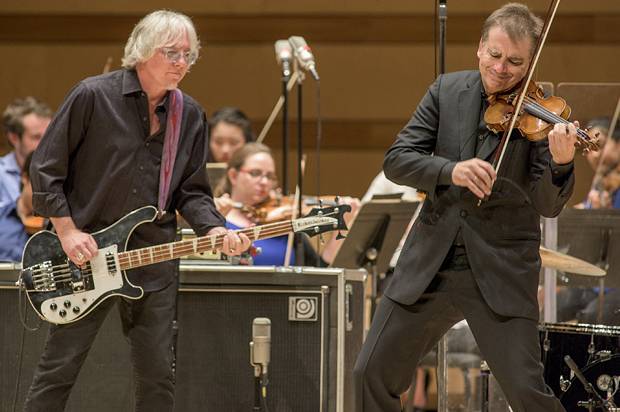Rock and classical worlds collide and converge in Mills’ violin concerto

Six years ago Robert McDuffie came to the Harris Theater to give the local premiere of Philip Glass’s Violin Concerto No. 2 (“The American Four Seasons”), a work the violinist commissioned, recorded, and performed on an international tour.
That project proved so successful that McDuffie elected to try it once again, this time commissioning and touring a concerto from longtime friend Mike Mills, a rock musician and former bass player of the popular group R.E.M.
The Harris Theater was the venue once again Monday night with McDuffie, Mills and colleagues giving the local debut of Mills’ Concerto for Violin, Rock Band and String Orchestra in the final stop on their 13-city tour.
Mills’ genre-traversing hybrid was clearly the main event, drawing an audience made up of R.E.M. fans as much as Harris’s usual classical patrons. Yet the artful program, also offering works of John Adams and Philip Glass, presented an inviting, not-too-long sampler of American classical music to newbies, and was equally well received, judging by the enthusiastic applause.
The evening led off with John Adams’ Road Movies, a violin sonata in all but name. McDuffie and pianist Christopher Taylor brought astringent bite to the asymmetric lines of the opening section (“Relaxed Groove”), nicely contrasted with McDuffie’s spacious take on the spare rumination of the middle movement. The violinist took the motoric finale (“40% swing”) at a blistering tempo–seeming very rock guitarist-like himself– with Taylor delivering comparably blazing keyboard support.
Chicago’s Fifth House Ensemble took the stage for the program centerpiece, Philip Glass’s Symphony No. 3.
Glass, who turns 80 on January 31, was in town last week to receive the Tribune Literary Award for his 2015 memoir, Words without Music. Chicago Opera Theater will mark the composer’s birthday anniversary with the local premiere of Glass’s opera The Perfect American in April.
Yet for a composer as prolific and popular as Philip Glass, his orchestral music remains strangely neglected locally, with the Chicago Symphony Orchestra having yet to perform a single one of Glass’s ten symphonies.
So one was even more grateful to be able to hear Glass’s Third Symphony Monday night. Though written for the Stuttgart Chamber Orchestra this music really benefits from a larger complement of strings. At times one wanted greater body and sonic impact from Fifth House’s 16 players, especially in the first movement, which felt too soft in focus and attacks.
Yet conductor Eli Chen showed that he had the full measure of Glass’s tricky idiom–pacing the music well, eliciting transparency and a striking range of dynamic nuance. Chen led a polished and atmospheric performance, conveying the ominous pulsing of the insistent lines and dexterously handling Glass’s shifting rhythms. The third movement was especially fine with Charlene Kluegel’s soaring violin providing a ray of light over the dark, driving insistence of the cellos and basses.
Mills’s concerto has received less-than-stellar reviews on this tour, with many critics complaining that it fails to bridge the two genres of rock and classical music. It’s a bit unfair to compare Mills’ maiden “classical” effort with that of composers like Adams and Glass, serious and experienced hands at gracefully mining the energy and dynamism of rock elements within classical structures.
In Mills’ hybrid the rock element is clearly dominant, with Mills on bass, two guitarists and a drummer joining McDuffie and the less visible (and often audible) Fifth House strings. Cast in six sections– calling them “movements” seems inapt–the concerto is more a varied suite than an integral concertante work for violin. It’s also a collaborative effort, with David Mallamud credited for “orchestration and additional music.”
The outer sections are mostly content to place bravura violin pyrotechnics over the driving rock band, with McDuffie as a kind of third ax man on fiddle, alongside the band’s excellent guitarists, John Neff and William Tonks. Rather than a crossover concerto it seems more suggestive of the violin and cello dressing applied to ELO, bringing back nostalgic memories of stumbling out of the Chicago Stadium in the 1970s.
Yet the sections are varied in expression and material. McDuffie and the rock band kick up plenty of raucous energy in “Sonny Side Up,” the driving rock music amusingly alternated with a pizzicato Rococo theme for violin and strings. In “Nightswimming,” Mills switches from bass to piano to introduce the melody from the same R.E.M. song, later delicately embroidered by McDuffie.
If Mills’ concerto doesn’t possess the craft and assurance of more experienced composers it proved an enjoyable confection and received full-throttle advocacy by McDuffie, the band and Fifth House strings.
Perhaps most importantly it was received with enthusiastic applause and cheers by the audience, and the program likely turned a lot of R.E.M. fans in their 30s and 40s on to music of John Adams and Philip Glass for the first time. “Play Firebird!” yelled one audience member, and that witty twist on the usual rock request reflected the engaged and informal atmosphere Monday night at the Harris, with rock and classical worlds converging as much as colliding.
Posted in Performances




